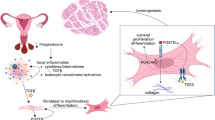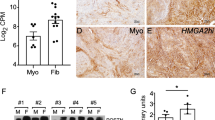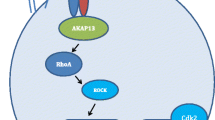Abstract
Evidence is growing that phthalate esters play an important role in the pathogenesis of estrogen-dependent gynecologic diseases, especially uterine fibroids. We aimed to investigate whether in vitro treatment with di-(2-ethylhexyl)-phthalate (DEHP) affects angiogenesis, proliferation, and apoptosis in uterine fibroids. To ascertain this, we evaluated vascular endothelial growth factor (VEGF) expression and AKT/ERT phosphorylation and compared the fibroid volume between nonobese diabetic/severe combined immunodeficiency (NOD/SCID) mice fed with and without DEHP. VEGF expression was measured using enzyme-linked immunosorbent assay, and AKT/ERK phosphorylation was analyzed by western blot analysis in human myometrial and fibroid cells. The volume of the fibroid tissues implanted to NOD/SCID mice was measured, and the expression of collagen type I protein, Ki-67, proliferating cell nuclear antigen, and B cell lymphoma 2 were analyzed using immunohistochemistry. We could see significant increases in VEGF expression and AKT phosphorylation in human myometrial and fibroid cells treated with DEHP. The volume of the fibroid tissues was significantly increased in NOD/SCID mice fed with DEHP, which was accompanied by increased expression of collagen type I and AKT phosphorylation. Taken together, these results suggest that exposure to phthalate esters may influence uterine fibroid pathogenesis by increasing VEGF and collagen expression and upregulating AKT phosphorylation.




Similar content being viewed by others
References
Baird DD, Dunson DB, Hill MC, Cousins D, Schectman JM. High cumulative incidence of uterine leiomyoma in black and white women: ultrasound evidence. Am J Obstet Gynecol. 2003;188:100–7. https://doi.org/10.1067/mob.2003.99.
Falcone T, Walters MD. Hysterectomy for benign disease. Obstet Gynecol. 2008;111:753–67. https://doi.org/10.1097/AOG.0b013e318165f18c.
Katz TA, Yang Q, Treviño LS, Walker CL, Al-Hendy A. Endocrine-disrupting chemicals and uterine fibroids. Fertil Steril. 2016;106:967–77. https://doi.org/10.1016/j.fertnstert.2016.08.023.
Vélez MP, Arbuckle TE, Fraser WD. Female exposure to phenols and phthalates and time to pregnancy: the Maternal-Infant Research on Environmental Chemicals (MIREC) Study. Fertil Steril. 2015;103:1011–1020.e2. https://doi.org/10.1016/j.fertnstert.2015.01.005.
Brehm E, Flaws JA. Transgenerational effects of endocrine-disrupting chemicals on male and female reproduction. Endocrinology. 2019;160:1421–35. https://doi.org/10.1210/en.2019-00034.
Bernard L, Décaudin B, Lecoeur M, Richard D, Bourdeaux D, Cueff R, et al. Analytical methods for the determination of DEHP plasticizer alternatives present in medical devices: a review. Talanta. 2014;129:39–54. https://doi.org/10.1016/j.talanta.2014.04.069.
Qian X, Li J, Xu S, Wan Y, Li Y, Jiang Y, et al. Prenatal exposure to phthalates and neurocognitive development in children at two years of age. Environ Int. 2019;131:105023. https://doi.org/10.1016/j.envint.2019.105023.
Rattan S, Zhou C, Chiang C, Mahalingam S, Brehm E, Flaws JA. Exposure to endocrine disruptors during adulthood: consequences for female fertility. J Endocrinol. 2017;233:R109–29. https://doi.org/10.1530/JOE-17-0023.
Piazza MJ, Urbanetz AA. Environmental toxins and the impact of other endocrine disrupting chemicals in women’s reproductive health. JBRA Assist Reprod. 2019;23:154–64. https://doi.org/10.5935/1518-0557.20190016.
Wolff MS, Teitelbaum SL, Mcgovern K, Windham GC, Pinney SM, Galvez M, et al. Phthalate exposure and pubertal development in a longitudinal study of US girls. Hum Reprod. 2014;29:1558–66. https://doi.org/10.1093/humrep/deu081.
Cobellis L, Latini G, Defelice C, Razzi S, Paris I, Ruggieri F, et al. High plasma concentrations of di-(2-ethylhexyl)-phthalate in women with endometriosis. Hum Reprod. 2003;18:1512–15. https://doi.org/10.1093/humrep/deg254.
Reddy BS, Rozati R, Reddy S, Kodampur S, Reddy P, Reddy R. High plasma concentrations of polychlorinated biphenyls and phthalate esters in women with endometriosis: a prospective case control study. Fertil Steril. 2006;85:775–9. https://doi.org/10.1016/j.fertnstert.2005.08.037.
Kim SH, Chun S, Jang JY, Chae HD, Kim CH, Kang BM. Increased plasma levels of phthalate esters in women with advanced-stage endometriosis: a prospective case-control study. Fertil Steril. 2011;95:357–9. https://doi.org/10.1016/j.fertnstert.2010.07.1059.
Kim YH, Kim SH, Lee HW, Chae HD, Kim CH, Kang BM. Increased viability of endometrial cells by in vitro treatment with di-(2-ethylhexyl) phthalate. Fertil Steril. 2010;94:2413–6. https://doi.org/10.1016/j.fertnstert.2010.04.027.
Kim SH, Cho S, Ihm HJ, Oh YS, Heo S-H, Chun S, et al. Possible role of phthalate in the pathogenesis of endometriosis: in vitro, animal, and human data. J Clin Endocrinol Metab. 2015;100:E1502–11. https://doi.org/10.1210/jc.2015-2478.
Bulun SE. Uterine fibroids. N Engl J Med. 2013;369:1344–55. https://doi.org/10.1056/NEJMra1209993.
Parker WH. Etiology, symptomatology, and diagnosis of uterine myomas. Fertil Steril. 2007;87:725–36. https://doi.org/10.1016/j.fertnstert.2007.01.093.
Leppert PC, Baginski T, Prupas C, Catherino WH, Pletcher S, Segars JH. Comparative ultrastructure of collagen fibrils in uterine leiomyomas and normal myometrium. Fertil Steril. 2004;82:1182–7. https://doi.org/10.1016/J.FERTNSTERT.2004.04.030.
Ohara N. Sex steroidal modulation of collagen metabolism in uterine leiomyomas. Clin Exp Obstet Gynecol. 2009;36:10–1 http://www.ncbi.nlm.nih.gov/pubmed/19400409. Accessed January 15, 2019.
Borahay MA, Asoglu MR, Mas A, Adam S, Kilic GS, Al-Hendy A. Estrogen receptors and signaling in fibroids: role in pathobiology and therapeutic implications. Reprod Sci. 2017;24:1235–44. https://doi.org/10.1177/1933719116678686.
Tal R, Segars JH. The role of angiogenic factors in fibroid pathogenesis: potential implications for future therapy. Hum Reprod Update. 2014;20:194–216. https://doi.org/10.1093/humupd/dmt042.
Kim JH, Kim SH, Oh YS, Ihm HJ, Chae HD, Kim CH, et al. In vitro effects of phthalate esters in human myometrial and leiomyoma cells and increased urinary level of phthalate metabolite in women with uterine leiomyoma. Fertil Steril. 2017;107:1061–1069.e1. https://doi.org/10.1016/j.fertnstert.2017.01.015.
Chou Y-Y, Huang P-C, Lee C-C, Wu M-H, Lin S-J. Phthalate exposure in girls during early puberty. J Pediatr Endocrinol Metab. 2009;22:69–77 http://www.ncbi.nlm.nih.gov/pubmed/19344077. Accessed December 9, 2018.
Colón I, Caro D, Bourdony CJ, Rosario O. Identification of phthalate esters in the serum of young Puerto Rican girls with premature breast development. Environ Health Perspect. 2000;108:895–900. https://doi.org/10.1289/ehp.108-2556932.
Reddy B, Rozati R, Reddy B, Raman N. General gynaecology: association of phthalate esters with endometriosis in Indian women. BJOG Int J Obstet Gynaecol. 2006;113:515–20. https://doi.org/10.1111/j.1471-0528.2006.00925.x.
López-Carrillo L, Hernández-Ramírez RU, Calafat AM, Torres-Sánchez L, Galván-Portillo M, Needham LL, et al. Exposure to phthalates and breast cancer risk in Northern Mexico. Environ Health Perspect. 2010;118:539–44. https://doi.org/10.1289/ehp.0901091.
Ahern TP, Broe A, Lash TL, Cronin-Fenton DP, Ulrichsen SP, Christiansen PM, et al. Phthalate exposure and breast cancer incidence: a Danish Nationwide Cohort Study. J Clin Oncol. 2019:JCO.18.02202. https://doi.org/10.1200/JCO.18.02202.
Durmaz E, Ozmert EN, Erkekoglu P, Giray B, Derman O, Hincal F, et al. Plasma phthalate levels in pubertal gynecomastia. Pediatrics. 2010;125:e122–9. https://doi.org/10.1542/peds.2009-0724.
Lewicka A, Osuch B, Cendrowski K, ŻEgarska J, Stelmachów J. Expression of vascular endothelial growth factor mRNA in human leiomyomas. Gynecol Endocrinol. 2010;26:451–5. https://doi.org/10.3109/09513591003632159.
McWilliams MM, Chennathukuzhi VM. Recent advances in uterine fibroid etiology. Semin Reprod Med. 2017;35:181–9. https://doi.org/10.1055/s-0037-1599090.
Hyder SM, Huang J-C, Nawaz Z, Boettger-Tong H, Mäkelä S, Chiappetta C, et al. Regulation of vascular endothelial growth factor expression by estrogens and progestins. Environ Health Perspect. 2000;108:785–90. https://doi.org/10.1289/ehp.00108s5785.
Sefton EC, Qiang W, Serna V, Kurita T, Wei J-J, Chakravarti D, et al. MK-2206, an AKT inhibitor, promotes caspase-independent cell death and inhibits leiomyoma growth. Endocrinology. 2013;154:4046–57. https://doi.org/10.1210/en.2013-1389.
Nierth-Simpson EN, Martin MM, Chiang TC, Melnik LI, Rhodes LV, Muir SE, et al. Human uterine smooth muscle and leiomyoma cells differ in their rapid 17/J-estradiol signaling: implications for proliferation. Endocrinology. 2009;150:2436–45. https://doi.org/10.1210/en.2008-0224.
Zota AR, Geller RJ, Calafat AM, Marfori CQ, Baccarelli AA, Moawad GN. Phthalates exposure and uterine fibroid burden among women undergoing surgical treatment for fibroids: a preliminary study. Fertil Steril. 2019;111:112–21. https://doi.org/10.1016/j.fertnstert.2018.09.009.
Pocar P, Fiandanese N, Secchi C, Berrini A, Fischer B, Schmidt JS, et al. Exposure to di(2-ethyl-hexyl) phthalate (DEHP) in utero and during lactation causes long-term pituitary-gonadal axis disruption in male and female mouse offspring. Endocrinology. 2012;153:937–48. https://doi.org/10.1210/en.2011-1450.
Gray LE, Laskey J, Ostby J. Chronic di-n-butyl phthalate exposure in rats reduces fertility and alters ovarian function during pregnancy in female Long Evans hooded rats. Toxicol Sci. 2006;93:189–95. https://doi.org/10.1093/toxsci/kfl035.
Zota AR, Geller RJ, VanNoy BN, Marfori CQ, Tabbara S, Hu LY, et al. Phthalate exposures and microRNA expression in uterine fibroids: the FORGE Study. Epigenet Insights. 2020;13. https://doi.org/10.1177/2516865720904057.
Funding
This research was supported by the Asan Institute for Life Sciences, Seoul, South Korea (grant 2018-323).
Author information
Authors and Affiliations
Contributions
Conceptualization, S.H.K.; methodology, Y.S.O., S.H.H., and K.H.K; software, Y.S.O; validation, Y.S.O., S.H.H., and K.H.K; formal analysis, Y.S.O., S.H.H., and K.H.K; investigation, H.J.K.; resources, D.Y.K.; data curation, H.J.K and Y.S.O.; writing (original draft preparation), H.J.K.; writing (review and editing), H.J.K. and S.H.K.; visualization, H.J.K.; supervision, S.H.K., S.R.L, and H.D.C.; project administration, S.H.K., S.R.L, and H.D.C. All authors have read and agreed to the published version of the manuscript.
Corresponding author
Ethics declarations
Conflict of Interest
The authors declare that they have no conflict of interest.
Ethical Standards and Informed Consent
All procedures followed were in accordance with the ethical standards of the responsible committee on human experimentation (institutional and national) and with the Helsinki Declaration of 1975, as revised in 2000. Informed consent was obtained from all patients for being included in the study.
Animal Studies
All institutional and national guidelines for the care and use of laboratory animals were followed.
Additional information
Publisher’s Note
Springer Nature remains neutral with regard to jurisdictional claims in published maps and institutional affiliations.
Rights and permissions
About this article
Cite this article
Kim, H.J., Kim, S.H., Oh, Y.S. et al. Effects of Phthalate Esters on Human Myometrial and Fibroid Cells: Cell Culture and NOD-SCID Mouse Data. Reprod. Sci. 28, 479–487 (2021). https://doi.org/10.1007/s43032-020-00341-0
Received:
Accepted:
Published:
Issue Date:
DOI: https://doi.org/10.1007/s43032-020-00341-0




